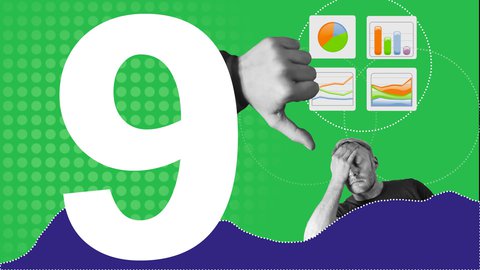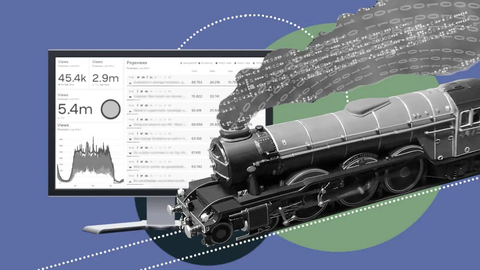Modern newsrooms are a far cry from those of yore. The days when it was they who set the agenda and schedule for news consumption have long gone. Today’s audiences know what they want - and need - from the news, and it couldn’t be more different to reading the morning edition front to back or waiting for an evening bulletin. They are citizens of the world and know their way around the internet. They set their own schedules, and follow their interests. While newsrooms know this, there’s still work that they need to do in order to adapt to this change in behaviour. And it all starts with how they work with data.
how newsrooms can transform into editorial action centres
Feb. 15, 2021 by Jacqueline Woudstra

to keep up with the whims of an online audience, you need to get into their heads
The necessity of digital transformation
The advent of internet, digital publishing and social media created a new online playing field that offered two options: keep up or lose.
Lose your audience, that is.
Because even though there still are older readers who value their paper, there will inevitably be a time when this new generation of digital natives is the audience. This new generation searches for news when they want it, and more often than not, they aren't loyal to just one brand. Monetisation of your content will not be as straightforward as selling papers anymore, and the advertising model has had its day. New business models will have to be explored and made a success, and that calls for a digital transformation.
In order to keep up with the whims of an online audience, you need to get into their heads - understand their needs, interests and biorhythms. Newsrooms are getting more focused, determining their audience needs, and are looking for direct feedback on their actions: what is effective and what isn't?
Analytics and data collection tools are the first step towards getting those insights. Data and technology has seeped into every aspect of the business. But it’s not just about the availability of raw data, the notable transformation has been in the evaluation of data and action following it. To make data driven decision making in the newsroom possible, just having the numbers will not do. You need to make it actionable. (We did a webinar on this, so take some time to watch the recording!)
Today's newsrooms are turning into nothing short of editorial action centres. A digital hub, where data is processed just as easily as interviews and press releases. Imagine a newsroom where the screens lining the walls didn't just show a tracker of most read articles, but did something much more actionable. What would happen if those screens explicitly told you what you needed to do to grow your articles' impact? How about notifications sent to editors and journalists to let them know when headlines are underperforming? Tables and graphs which are instantly understandable without a call to IT? What once sounded like something out of a science fiction movie, is now reality.
online readers demand value - can you give them that?
Gaining the favour of online audiences
Every brand and platform vying for the attention of online readers results in two things:
- Readers' expectations get higher with every new platform, format or channel that's introduced.
- It becomes more and more difficult to be truly present and relevant for any publisher.
In order to remain visible, some brands just do more of what they were already doing, creating more of the same content and sending out push notifications at the drop of a hat. All this achieves is that the reader becomes even more picky about what they consume. More of what you're already doing will not help, it has to be different. But how?
Not every business will be able to jump on every trend that emerges with hopes of winning the favours of their target audience. Instead, it pays to capitalise on the uniqueness of what they have to offer. Online readers are looking for value. What can you do to give them that? Value comes from the right timing, format and tone of voice, combined with a good mix of content, attuned to your target audience.
Ask yourself:
- What am I currently doing to attract new and returning readers?
- Is the brand identity evident in all the content that you publish?
- What is the mission and vision of the brand? What does it stand for?
the party is at the bus stop
Creating value for the reader
We've established that a different way of working is indispensable when it comes to pleasing modern audiences. It also requires a different mindset, which says that it’s okay if your readers are engaged on channels that are not your own. It may be counterintuitive to not lead readers directly to your own website or app, but just try to make the most of the engagement you're getting where you're getting it. The party is at the bus stop, as we say; it's not always necessary to make them get on the bus. Facebook may even penalise you for using your timeline solely to drive traffic away to your own website, so don't risk losing your organic reach.
Providing value on every channel that you're active on rewards you with a wealth of data. That's the currency you'll receive as payment for your efforts, and make no mistake, this is just as valuable as pageviews on your website. Just be sure you make the most of what this channel can teach you about your readers, their behaviour, biorhythm and interests. Keep an eye on the numbers - and the right ones at that.
Ask yourself:
- Who is the target audience, when and where are they active, and what do they expect?
- Where am I active now? Do I need to focus on different channels?
Metrics that progress your online content strategy
Okay, so data is good. Does that mean that all data will do? Or that more data is even better? Well, no. It's important to only measure what matters. Here are some suggestions:
- Which of your stories are most popular, and how long do people interact with them? Attention time is valuable! Remember: clickbait might be good for pageviews, but it’s bad for loyalty.
- How many of your readers are returning visitors, and what type of content do they like?
- What type of story gets the most engagement?
Furthermore, it's important to measure things that you can act on, like how successful a headline is or how much interaction a story generates on different channels.
As Dmitry Shishkin, our partner in the Triple N project said, "It’s clear that while many newsrooms are drowning in data, and editors have even less time to process all insights, the winning solution lies in true actionability." Don't be overwhelmed by data, but focus on the insights and statistics that you can act on, and that help you progress your strategy.
The AI-ready newsroom
Writing robots are not here to take jobs, but to make jobs easier. AI could take mundane tasks from journalists' hands, so they can focus on creating more labour-intensive, valuable stories (such as those written with a news user needs perspective). This requires the creation of an environment where robots know what to do, starting with workflows and automated tasks following a certain event. On the one hand, you need reports to evaluate performance and past successes. On the other, you need real-time data insights to respond to what's currently happening. It's a bit like predictive analysis: if you've seen a certain thing succeed in the past, you could try and recreate the situation, with slightly different factors, honing your strategy.
Ask yourself:
- If A or B happens, what's action C?
- Do we have the necessary data sources to track activities, evaluate, and automate tasks?
Is your newsroom future proof?
Is the newsroom only viable anymore if it's willing to transform into an editorial action centre? We believe it is. Whether the business model relies on eyeballs or reader revenue, it's necessary to know which content works where and when. Data and analytics are necessary tools to gain these insights. To please tomorrow's audience and keep the newsroom a pleasant place to work, you also need an actionable strategy and an environment where in the future synthetic media or AI and machine-learning could thrive.
Change is not always easy, or fun. But there are ways to make it better, starting with understanding why it's necessary. Make plans, think of something to work towards and celebrate your successes.
Useful tools to future-proof your newsroom:
- Big Screen for real time data -> part of smartocto Realtime
- A/B testing -> smartocto Tentacles
- Notifications that help you act on the data -> part of smartocto Realtime
- Reports to evaluate -> smartocto Insights
We'd be happy to tell you more about these!
you may also like...
9 reasons why your analytics fail in the newsroom
A screen with graphs and numbers alone isn't enough to transform workflows and optimise content in the newsroom. Why a traditional analytics approach often fails.

Data driven vs data informed (and beyond)
What is the attitude of today's newsroom towards data? What role does data play? A better question would be: how can data serve you?
